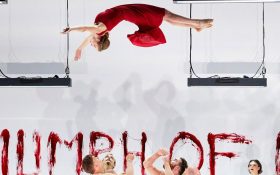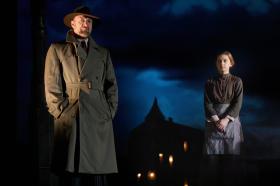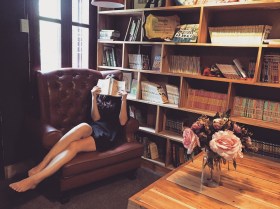The long, narrow table is set for dinner, its crowded white surface a visual feast Conversations about fashionable things – design, aesthetic, function – abound. Strangely absent, however, is chatter about culinary delights. As the centre-piece for the UK Design Council’s international touring exhibition, Great Expectations, the dinner table is laden only with food for thought. In this case, a mix of innovative products from Britain’s most progressive and experimental designers.
Great Expectations, as its names suggests, is a celebration of all (design) things British. However, rather than an exploration into England’s Dickensian past, the aim of this exhibition is to provide an insight into current trends in British innovation and to set an expectation of what is yet to come. Certainly, the fact that the exhibition is the winner of the Design Week ‘best of show 2002’ award and the FX International Design award, suggests that the world is definitely listening.
‘The impetus for the exhibition came really from concerns about Britain’s reputation and image abroad,’ says Steve Annett, Head of Communications at the UK’s Design Council, who is currently in Australia to promote Great Expectations, following exhibitions in New York City, Montreal, Ottawa, Shanghai and Tokyo.
‘The British Council did research around the world and found that Britain’s image often tends to be associated with history, tradition and the past and – while we don’t have a problem with the fact that we’re a very old country – when it comes to business, innovation and creativity, we are very modern, and we think our design and innovation is cutting edge. We put Great Expectations together to try and address that, and to demonstrate that, when it comes to design, we’re really world class.’
Indeed, design is a very big deal in the UK. Industry figures from the British Design Initiative and the Design Council value the design and consulting sector in Britain at US$7.5 billion, with around $1.5 billion coming from overseas earnings. Annett points out too, that British businesses are becoming increasingly design-focused, so that innovation and creativity is incorporated into products and services.
‘London is a very major design hub,’ says Annett. ‘There are more designers in London than in any other city in the world, and the design consultancies [there] earn a lot of serious money providing design services around the world… We want people to know that the British design industry is very strong, and we also want to show the important link between business and design, and the contribution made by designers to successful business.’
Within this context, Great Expectations exhibits a range of functionally innovative products – from a self-cooling drink can, to a laundry basket that both weighs and delivers clean clothes for its owner – from an array of disciplines including architecture, advertising, fashion, interactive media, software, graphics, film and television.
‘Design isn’t a luxury,’ explains Annett, in an effort to highlight the importance of good design to all these areas. ‘In the modern world it’s absolutely essential. I think in the UK there’s a recognition of that in business and government, and this is [signified through] talk about a “knowledge economy,” an economy in which value is added through specialist knowledge and expertise.’
‘Tony Blair recently talked about Britain transforming from being the “workshop of the world” to the “design studio of the world,” and I think a lot of British businesses are doing that. There is a recognition that you can’t compete on price anymore. However cheaply you make something, there will always be others who can make it more cheaply. Good design is a way to add value.’
While the Great Expectations exhibition itself cost more than US$100 million to design, build and deliver, Annett cautions that it has more to do with ‘general conscience raising’ and ‘awareness raising’ than trade. ‘Its about design and innovation, as opposed to selling product,’ he says. In light of this, another talking point raised by the exhibition, is the cross-over between design and more traditional forms of visual art.
‘If you actually look at the exhibition, and the designers involved,’ he says, ‘you’ll see that there are quite a lot of designers there who work on the border of design and art. Generally, we’re not at the “art” end of the spectrum – I don’t think people interested in art will necessarily get too excited about a robot vacuum cleaner – but there is some fashion design, graphic design and digital design there that combines the best of both worlds.’
Whether their interest is in innovative products, networking opportunities or pure aesthetic beauty, audiences around the world have flocked to Great Expectations. Annett says that in New York City, the exhibition received 55,000 people in ten days, while in Shanghai, “we were mobbed.” In terms of bringing British design to the rest of the world then, it seems we can expect Great Expectations to be a resounding success.
Arts Hub will profile three designers whose work features in Great Expectations in the coming weeks, including Frith Kerr, who designed the sculptural signage for the exhibition; Paul Priestman, founding director of Priestman Goode, responsible for the new Virgin Trains designs; and Thomas Heatherwick, whose public artworks include the soon-to-be-produced ‘B of the Bang’ sculpture in Manchester.




